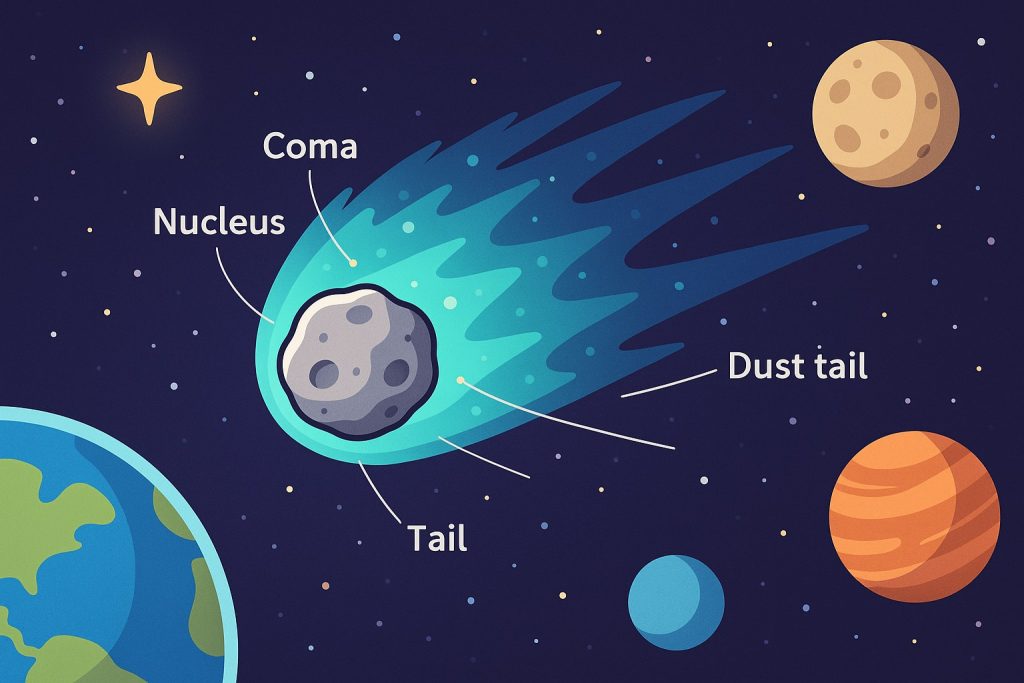Comets are some of the most mysterious and beautiful objects in the Solar System. With their glowing heads and long, streaming tails, they’ve fascinated humanity for thousands of years — once feared as omens, now studied as ancient cosmic time capsules. But what exactly are comets, where do they come from, and why do they matter?
What Is a Comet?
A comet is a small celestial body made mostly of ice, dust, and rock. Often described as a “dirty snowball,” it spends most of its life far from the Sun, in the cold outer reaches of the Solar System. When it approaches the Sun, solar heat causes its icy core to vaporize, creating a glowing coma and one or more tails.
Structure of a Comet
- Nucleus
- The solid core, typically only a few kilometers wide
- Made of frozen water, methane, ammonia, and dust
- Coma
- A cloud of gas and dust surrounding the nucleus
- Forms as the Sun warms the comet
- Tails
- Ion tail: made of electrically charged particles pushed directly away from the Sun by the solar wind
- Dust tail: made of small particles curved by the comet’s path and solar radiation
Comet tails can stretch for millions of kilometers, always pointing away from the Sun.
Where Do Comets Come From?
Most comets originate from two distant regions:
- Kuiper Belt – a disc-shaped region beyond Neptune with short-period comets (return every few years to centuries)
- Oort Cloud – a spherical shell far beyond the Solar System, home to long-period comets (may take thousands of years to orbit once)
Gravitational nudges from stars or planets can send these icy bodies inward toward the Sun.
Famous Comets
- Halley’s Comet – The most famous, visible from Earth every 76 years (next in 2061)
- Comet Hale–Bopp – A spectacular comet visible to the naked eye in 1997
- Comet NEOWISE – A surprise visitor in 2020 with a bright, curved tail
- Shoemaker-Levy 9 – Slammed into Jupiter in 1994, showing how comets can impact planets
Why Are Comets Important?
Comets are primitive remnants from the early Solar System, over 4.6 billion years old. Studying them helps scientists:
- Understand planet formation
- Learn about the origin of water and organic molecules on Earth
- Monitor impact risks — comets can hit planets just like asteroids
Space Missions to Comets
- Rosetta (ESA): orbited and landed on Comet 67P/Churyumov–Gerasimenko in 2014
- Deep Impact (NASA): crashed a probe into Comet Tempel 1 in 2005 to study its interior
- Comet Interceptor (upcoming): will fly by a yet-to-be-discovered comet and observe it up close
Can Comets Be Dangerous?
While most comets pass at safe distances, a direct collision with Earth could have catastrophic effects. Though rare, comets move fast and are difficult to detect early. Scientists constantly monitor the skies for new or returning comets that could pose a threat.
Conclusion
Comets are icy travelers that offer a glimpse into the Solar System’s deep past. Their sudden appearances, luminous tails, and cosmic journeys have inspired both wonder and scientific curiosity. By studying comets, we not only admire their beauty but also unlock secrets about the origins of Earth and the universe itself.
Glossary
- Coma – the glowing cloud of gas and dust around a comet’s nucleus
- Nucleus – the solid central core of a comet
- Ion tail – the straight tail made of charged particles
- Kuiper Belt – a region beyond Neptune filled with icy bodies
- Oort Cloud – a distant, spherical zone thought to be the source of long-period comets


